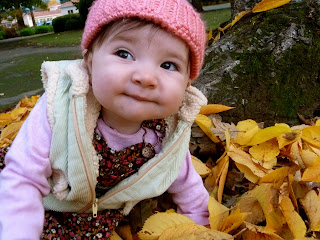Over Thanksgiving Break, I asked some family friends if I could do a photography shoot of their foster baby, Grace. Grace is 6 months old, and in general a happy and content baby. Her sister Ali helped me by playing with Grace while I took the photos. First I chose her outfit. She wore a long sleeve pink shirt, with flowered overalls, a corduroy vest, and a salmon pink hat. My main focus was her facial expression. the angles, and the contrast of colors. I was not able to take as many of the different shots as I had liked due to her short attention span and the chilly weather. We spent about half an hour at a park downtown.
Although the photos may seem quite similar it adds to the dynamic of the collection. Each photo was carefully edited and chosen. I also paid close attention to composition. I find photography of people more difficult than still objects, scenery, and nature, but a variety is important. I think that babies are easier to photograph than older children and adults.
I had not done much research on Anne Geddes, but I read some tips on taking photos of babies. The lighting was slightly overcast, which was nice because it was bright enough but the sun wasn’t glaring. The following post has a collection of the photographs. I spent time editing them, cropping, adjusting colors, and tones. While taking them some of the scenes included Grace sitting, being held, crawling, laying on her stomach, playing with, and eating leaves. In one of them the effect of falling leaves is present.
The family really liked the photos and had a photo scrapbook printed. I enjoyed taking pictures of Grace and the following posts have more photos, that are specifically grouped in type. I have gone into more detail on those posts. I also wrote a biography about the famous photographer Anne Geddes and selected three samples of her photos and a description on her techniques.
Although the photos may seem quite similar it adds to the dynamic of the collection. Each photo was carefully edited and chosen. I also paid close attention to composition. I find photography of people more difficult than still objects, scenery, and nature, but a variety is important. I think that babies are easier to photograph than older children and adults.
I had not done much research on Anne Geddes, but I read some tips on taking photos of babies. The lighting was slightly overcast, which was nice because it was bright enough but the sun wasn’t glaring. The following post has a collection of the photographs. I spent time editing them, cropping, adjusting colors, and tones. While taking them some of the scenes included Grace sitting, being held, crawling, laying on her stomach, playing with, and eating leaves. In one of them the effect of falling leaves is present.
The family really liked the photos and had a photo scrapbook printed. I enjoyed taking pictures of Grace and the following posts have more photos, that are specifically grouped in type. I have gone into more detail on those posts. I also wrote a biography about the famous photographer Anne Geddes and selected three samples of her photos and a description on her techniques.
Playing in the Leaves...
Piles of Leaves...
Falling Leaves...
Eating Leaves...
Laying in the Leaves...














































